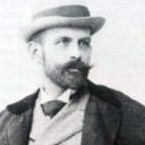Muthesius, Hermann *Grossneuhaus, 20 April 1861; + Berlin, 26 Oct 1927). German architect, architectural historian, theorist and critic.
He worked with Ende & Böckmann, one of the leading architectural firms in Berlin, who employed him in Tokyo (1887-91), where he designed a Gothic Revival German church.
On his return to Germany he joined the Ministry of Public Works and was appointed technical attaché (1896-1903) to the German Embassy in London. In England he studied the work of the English country-house architects from about 1870: the earlier figures, Philip Webb and R. Norman Shaw, and his own contemporaries C. F. A. Voysey, Edwin Lutyens and W. R. Lethaby.
He published several accounts of his investigations of English architectural culture, most notably the three-volume Das englische Haus (Berlin, 1904-05). This detailed study, which considers the house, and architecture in general, as an expression of the society of which it is a part, expressed Muthesius?s enthusiasm for England and his belief that the immediate future belonged to this style of building.
It was much admired in England, but its effect in Germany was to provoke controversy; even in the 1920s a copy was still kept locked away from students of the Technische Hochschule, Berlin. Although keen to promote an awareness of the functional and practical in architecture, Muthesius did not go so far as to see the form of a house as merely the result of fulfilling functional needs.
He never denied that the architect was an artist, motivated by the desire to give a convincing visual expression. Indeed his admiration went to artistically minded architects, such as Lutyens and Charles Rennie Mackintosh, who became a close friend, rather than to the more severely rational, such as Voysey.
Foto: Karolinsky-Archive
